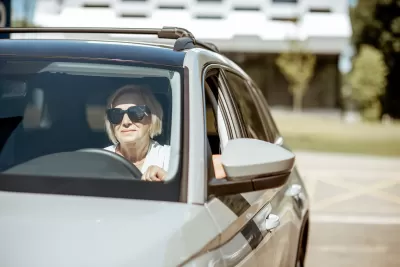Limited transit options and a lack of walkability mean more older Americans will continue to drive their cars as they age.

A survey conducted by the AARP reveals that many older Americans don’t believe they’ll ever have to stop driving, according to an article by Lloyd Alter.
The survey finds that adults 50-plus expect to make changes as they age, including bathroom changes and even anticipate the need for ramps and chair lifts. But there is no mention anywhere of the most significant and dramatic change in people’s lives as they age: the ability to drive.
Studies have found that older drivers can expect roughly seven to 11 years of life after driving becomes difficult or impossible. “That might mean 11 years of failing health in a single-family house in the suburbs, without a car, without family nearby, and without being in a walkable neighborhood.” And a 2020 study found a preference for personal vehicles even when public transit is available. “As a result, driving is synonymous with personal transportation mobility, and driving cessation is associated with loss of independence combined with becoming a burden to family and friends,” that study noted.
The AARP survey includes recommendations for how communities can better accommodate older residents and provide alternatives to driving. For Alter, “We need accessible housing, and walkable communities with good sidewalks, corner stores, medical facilities and coffee shops within a reasonable distance. We need good safe accessible transit for when we have to go further. We all must prepare for a non-driving future.”
FULL STORY: Survey: Boomers Don’t Accept That They Won’t Be Able To Drive Forever

Study: Maui’s Plan to Convert Vacation Rentals to Long-Term Housing Could Cause Nearly $1 Billion Economic Loss
The plan would reduce visitor accommodation by 25,% resulting in 1,900 jobs lost.

North Texas Transit Leaders Tout Benefits of TOD for Growing Region
At a summit focused on transit-oriented development, policymakers discussed how North Texas’ expanded light rail system can serve as a tool for economic growth.

Why Should We Subsidize Public Transportation?
Many public transit agencies face financial stress due to rising costs, declining fare revenue, and declining subsidies. Transit advocates must provide a strong business case for increasing public transit funding.

How to Make US Trains Faster
Changes to boarding platforms and a switch to electric trains could improve U.S. passenger rail service without the added cost of high-speed rail.

Columbia’s Revitalized ‘Loop’ Is a Hub for Local Entrepreneurs
A focus on small businesses is helping a commercial corridor in Columbia, Missouri thrive.

Invasive Insect Threatens Minnesota’s Ash Forests
The Emerald Ash Borer is a rapidly spreading invasive pest threatening Minnesota’s ash trees, and homeowners are encouraged to plant diverse replacement species, avoid moving ash firewood, and monitor for signs of infestation.
Urban Design for Planners 1: Software Tools
This six-course series explores essential urban design concepts using open source software and equips planners with the tools they need to participate fully in the urban design process.
Planning for Universal Design
Learn the tools for implementing Universal Design in planning regulations.
City of Santa Clarita
Ascent Environmental
Institute for Housing and Urban Development Studies (IHS)
City of Grandview
Harvard GSD Executive Education
Toledo-Lucas County Plan Commissions
Salt Lake City
NYU Wagner Graduate School of Public Service





























